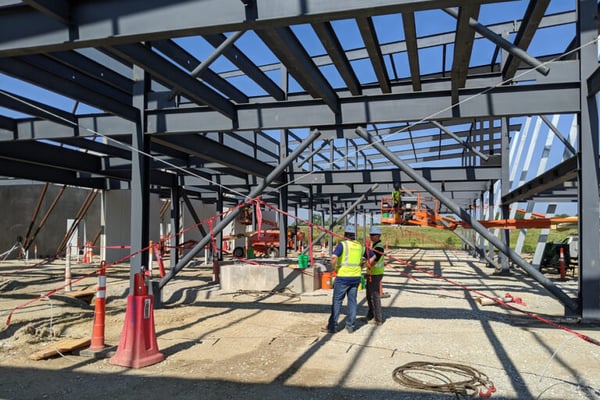3 Types of Building Project Contingencies

A week later, your contractor calls and delivers some terrible news: the soil report missed a limestone outcropping beneath a portion of your site. To create a solid foundation, they will need to hire a soil excavation expert, an unforeseen construction cost.
Luckily, you prepared ahead and allowed for contingencies in your budget.
Contingencies are a portion of a project’s budget that a building owner sets aside for unforeseen circumstances. Every building project presents unknowns, but contingencies create a buffer.
On every project we undertake, we help building owners manage costs by factoring contingencies into every phase of a project. We want to help you prepare for the worst-case scenario, which is why we created this straightforward guide to three types of contingencies:
By the end of this article, you will know how an architect manages costs, how contingencies reduce risk, and how much of your budget you should set aside. With this information, you can enter your building project confidently, knowing you have planned for the unexpected.
3 Types of Contingencies
1. Design Contingencies
The beginning of the architectural process presents many unknowns. Although you may know what spaces you need, you may not know the true extent of the work. A design contingency sets aside a portion of the budget so the architect can manage costs while exploring options.
To get a full understanding of the project and its cost, your architect will need to determine:
- The types of spaces you need (programming elements)
- Your sustainability goals
- The level of finishes you want
- Material prices
- Site and soil conditions
- Condition of the current space (for renovations)
- Market conditions and the likelihood of price increases or inflation
This list is not exhaustive, but it highlights some of the unknowns you are likely to encounter. As the architect gains a better understanding of the project, the design contingency reduces, and the construction cost estimate gets more accurate.
For example, our design contingencies are usually 20% of the construction cost in Pre-Design. As the design process progresses and less and less is unknown, the design contingency reduces as follows:
- 15% in Schematic Design
- 10% in Design Development
- 5% in Construction Documents

Design contingencies decrease as the architect gains a better understanding of the project
Design Contingencies vs. Escalation
Design contingencies differ from escalation. On a building project, escalation is a prediction of costs increasing over time. Typically, cost estimators will predict until the mid-point of construction and budget the cost as a separate line item.
On many projects, escalation will be 4% of the construction cost annually. When the market is more volatile, your architect may estimate more to prepare for greater price increases. Like design contingencies, escalation estimates help control costs and assure you have enough funds to complete the project.
2. Bidding Contingencies
When construction documents are complete, the design contingency transitions to a bidding contingency. Depending on your project delivery method, your project will now go out to bid. In this phase, you will set aside a contingency to prepare for any bid day anomalies.
By the end of the Construction Documents phase, your architect will provide a cost estimate. However, projects may bid higher than expected due to:
- Last-minute material price increases
- Other projects bidding at the same time, reducing competition among contractors
- An oversite in the architect’s estimates
To plan for these situations, your architect will usually recommend a bidding contingency of 5% of the construction cost. This provides more assurance that bids are within the expected range.
3. Construction Contingencies
Like all phases of a building project, construction presents unknowns. When an unexpected situation arises during construction, the building owner or contractor will request a change order and modify the scope of work.
Change orders can include any deletion, substitution, or addition to the original contract, including:
- Owner-requested changes to materials and spaces
- Errors or omissions in the construction documents
- Unforeseen conditions with the site
Let’s go back to our original example. If the contractor discovers a problem with the site’s soil condition, the architect will issue a change order and add corrective work to the project’s scope.
If you are not properly prepared, these changes can be costly, which is why your architect will recommend a construction contingency. On most projects, a construction contingency is 5% of the construction cost. For renovations, we recommend a contingency of 7-8%. Renovations present more risk and more unknowns, increasing the likelihood of change orders during construction.
Construction contingencies are usually held by the owner, meaning you will set aside the sum. Your contractor can also build the contingency into your construction cost. This means you will pay for the contingency throughout construction and receive any unused portion after construction completes.
In either case, your architect will work to provide you with the most accurate estimation for your contingency. At Neumann Monson, our Quality Assurance team rigorously checks our drawings and specifications before the project goes out to bid. Our goal is to reduce the likelihood of change orders, so the project is a success.

Construction contingencies are usually 5% of the construction cost for new buildings and 7-8% for renovations.
Planning for Building Project Contingencies
Contingencies help you manage costs and reduce risk. They act as a kind of insurance, preparing your budget for unexpected situations that arise.
Design contingencies help estimate costs while you plan the project, and bidding contingencies cover any bid day anomalies. Perhaps most importantly, construction contingencies cover any unexpected circumstances that arise while the project is underway, maintaining your budget.
Throughout the design process, your architect will incorporate these contingencies into your budget, which you will see listed as a separate line item.
On your hypothetical building project, the limestone outcropping beneath your site was certainly a surprise. Since you budgeted for a construction contingency, however, you can cover the cost of soil excavation and keep your project on track.
Now that you know about contingencies, you are better prepared to manage your construction costs. Start budgeting for architectural services by reading our guide to basic and supplemental services or the factors that influence architecture fees.